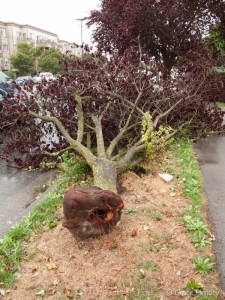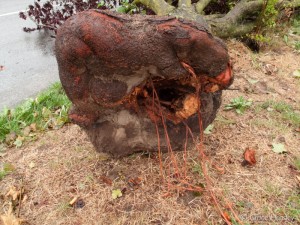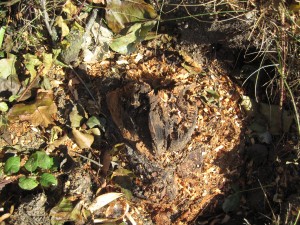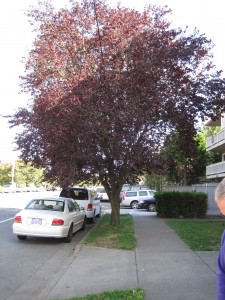The end of August brought an unseasonable rain- and windstorm to the Puget Sound region. We had some spectacular tree failures which I missed seeing as I was out of town. But one of our Facebook group members, Grace Hensley, was on the ball and took some great photos of a fallen purple-leafed plum. The first thing you see is the complete lack of a stabilizing root system.

Now look at the base of the trunk, which is actually a massive circling root that has girdled the trunk over time.

By now you must be able to see the orange twine extending from the base of the tree to the soil. Yes, those are the remains of the balled-and-burlapped clay root ball that was planted many years ago. Commercial landscapers will assure you that tree roots can grow through the burlap and establish. And this is sometimes true, as in this case.
But what doesn’t happen when the whole B&B mass is plopped into the ground is that circling woody roots aren’t discovered and corrected. Over the decades what started as a small circling root grew bigger and bigger, slowly squeezing the trunk and preventing it from developing girth at that point. It’s kind of like a blood pressure cuff being pressurized but never released.

In time, the constricted point becomes so unstable that the tree breaks. Look are how small the trunk that’s still in the ground is compared to the trunk of the tree itself. Windstorms are often the final push these failing trees need.

Commercial landscapers say it’s too costly to remove the twine and burlap and clay surrounding the roots, not to mention doing any of the corrective root pruning that might be needed. It’s easier to just plant the whole thing and cross your fingers that the tree lives past the warranty date. This is what happens when you consider a tree as just another design element rather than a living organism.
As a homeowner, however, you can insist that your trees are planted correctly (if you have someone else do the work). Or you can do it yourself. The bare-root method (sometimes called root washing) is an emerging science and it requires thoughtfulness, but it’s certainly better than the conventional approach in terms of long term tree health.
I have just come across your fine blog and will be returning many times!
Your pictures are wonderfully spectacular, clearly show bad practice and to me as a former horticultural lecturer would have been meat and drink to illustrate botanical phenomena.
I know very little of the specifics of b and b planting which is not much used here in the UK.
I have seem several examples of root strangulation but think of it as a fairly rare event.
I have no brief for landscapers cutting corners but wonder if a few sensational examples damn a whole industry practice? I guess ‘doing the job properly’ might increase the cost to the customer.
In the US, B&B trees are common especially for larger specimens. So the phenomenon of girdling roots isn’t unusual, and arborists I’ve spoken to across the country say this is a frequent problem. I agree that this *might* increase the cost to the customer, but if the installer then gave a longer warranty (5 or 10 years rather than 1) they may be more willing to pay more.
It is very clear that the writer has an agenda in prescribing that trees be planted only by washing soil from roots, and exaggerating the ill effects of planting a root ball with soil intact. I presume that there are facts to support the massive failure of trees implied by this article. Otherwise, the writer should advise that this is a suggestion that she personally finds most successful.
It should be clear, and in particular coming from this blog, that one tree’s failure is not evidence that the planting method used by most professionals is incorrect. In fact, observation and experience do not support the writer’s conclusions at all. There are thousands, perhaps millions of trees that have been planted the old fashion way, with most growing successfully into old age.
Possibly, the root washing method is better in some, or even in all circumstances, but the writer’s cause is not well suited with this poorly reasoned argument. I expect that the writer should also take into account when recommending this planting method that many (or most trees) are not planted while dormant, and many are planted in less than ideal weather conditions and with a tree owner who is unlikely to follow a strict irrigation regimen. These are practical considerations that should be addressed before I can consider this emerging science.
I’m curious as to what my “agenda” is. If it’s helping people understand the number of problems that can slow or prevent plant establishment, then sure, that’s my agenda. In addition to circling/girdling roots, trees left intact can be planted too deeply because the root crown is buried in the B&B ball. And differences in soil texture (i.e., clay in the ball and a sandy soil on site) inhibit water movement between the roots and the native soil. This makes it more difficult for the tree to establish. In B&B trees that I’ve seen that have failed to thrive or establish, most if not all are still intact in their clay ball. Research from decades ago demonstrated that in comparing bare root, containerized, and B&B plants that the B&B showed the least transplant stress initially, but within three years the bare root outperformed trees from the other production methods. I don’t believe the research looked at why, however, which is what the current question is.
Bare-rooting the tree allows the roots to immediately be in contact with the surrounding soil. That’s the ultimate goal, right? Why increase the stress on the tree by forcing the roots to grow through the clay and burlap before they reach the site soil – if they ever do? Of course care must be taken during and after transplanting to keep the roots moist. What would be interesting is for the industry to collect data on what installer replacement rates are. I’ve only spoken to one landscaper who went from a 10% per year replacement rate to virtually 0% after adopting this method. If installers saw this type of cost savings, would they be more likely to modify their methods?
As I said, the research on this topic is emerging, not established. I’ve published a peer-reviewed publication based on experimental research of this method as have others. Others are actively studying the question. It takes a while to generate research on problems like this (we’re looking at years for trees studied in field situations).
Cite the ANSI Z60 Standard. Growers and planters should follow the national rules.
Failures from poor growing and planting are common. they are just not as obvious because it is a slower death.
The owner of that plum may have saved $5 at the time of planting thanks to the minutes saved by poor practice, but it sure cost them in the long run!
Wow that is so extremely frustrating to see!